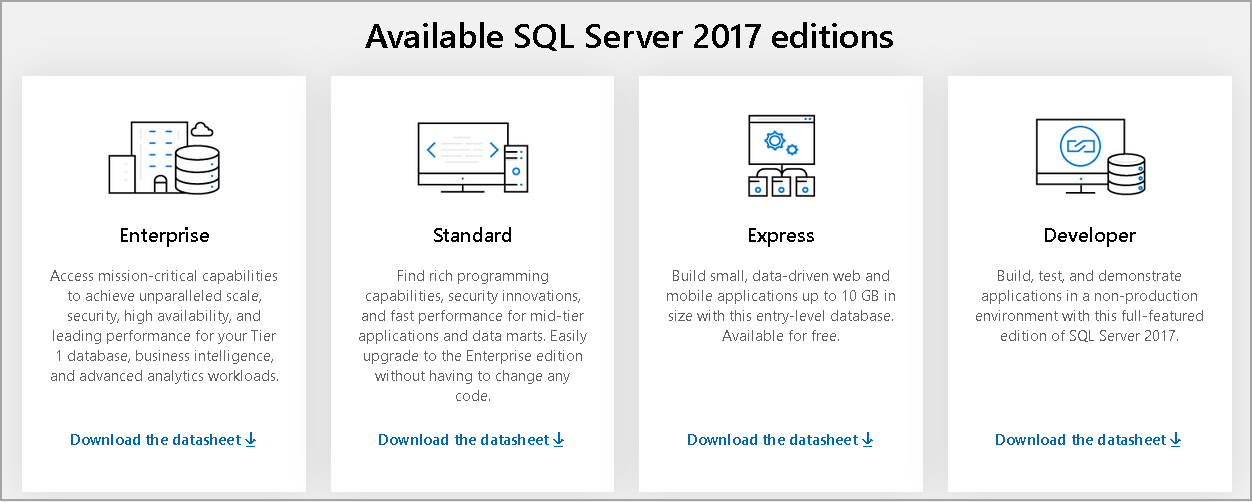

- #Sql server 2012 enterprise edition vs core how to#
- #Sql server 2012 enterprise edition vs core install#
- #Sql server 2012 enterprise edition vs core Offline#
You have to go into your VM library, hold down the Option key on your keyboard, right-click on the VM, and continue holding down the Option key as you click “Open Config File in Editor.” The server-grade vSphere documentation applies to Fusion, too, so here’s how I built a 12-core guest with offline CPU cores and memory nodes: VMware doesn’t enable you to build really dumb VM configurations by default. That way, both of your 16-core CPUs will get activity, and it’ll balance out the heat & memory better between the processors (instead of only lighting up the threads on the first 16-core processor.) Bonus track: demoing this in VMware Fusion You could use all of your cores by upgrading to Enterprise Edition, but…really, who wants to pay $7,000 per core to do that? Instead, use affinity masking to configure alternate cores as active so that you can balance the workloads more effectively across the underlying physical CPUs.įor example, say you’ve got 2014 Standard (which maxes out at 16 cores, 32 hyperthreading), and you’re running it on a 2-socket, 16-core-per-CPU server with hyperthreading enabled (for 64 total cores.) You would configure SQL Server to use every other core so that it uses 32 of the 64 cores, but just every other core. SQL Server Standard Edition is limited as to how many cores it can access: 2014 & prior cap out at 16 cores (32 with hyperthreading), and 2016 & newer cap out at 24 cores (48 with hyperthreading.) If you try to run one of these on, say, a 64-core server, you’ll encounter this error. Another cause: running Standard Edition on big servers

Be aware, of course, that your CPU percent-busy may suddenly get higher (worse) – but that’s a good thing, because it means you’re using all that horsepower you paid for.

#Sql server 2012 enterprise edition vs core how to#
How to tell if you’re having this problem – and fix it This is an informational message no user action is required. SQL Server detected 8 sockets with 1 cores per socket and 1 logical processors per socket, 8 total logical processors using 4 logical processors based on SQL Server licensing. There’s another clue buried in the SQL Server startup log: You see all 8 cores – you just can’t use ’em because they’re offline, as shown in sys.dm_os_schedulers: This is notoriously tricky because if you open SQL Server Management Studio, right-click on the server, and click Properties, it looks like everything’s okay. Here’s an example of a reader who ran into the problem after reading this post – note how their first four cores are getting hammered, and the rest are sitting saved my day. Our wait stats will show SOS_SCHEDULER_YIELD out the wazoo, but our sysadmins will say, “There’s plenty of available CPU power – you’re just not using it.” No matter how much load our SQL Server gets, it’ll only use 4 cores – meaning CPU will only hit 50% busy. Standard Edition will only use the first 4 cores here, and that’s it. Here’s a screenshot of Task Manager in a poorly configured VM: 8 sockets, each with 1 coreĪt the right, see how it says “Sockets: 8”? That means we set the VM up with 8 CPUs, each of which has a single core. So if you configure a virtual machine with, say, 8 virtual processors, you have to be really sure that you don’t accidentally end up with 8 sockets. Here’s the catch: the lesser of 4 sockets or 24/16 cores. See, these editions have a tricky limitation – let’s look at the documentation: Standard and Web Edition Limitations
#Sql server 2012 enterprise edition vs core install#
When you install SQL Server Standard or Web Edition in a virtual machine with more than 4 cores, things can look like they’re just fine – when in reality, you’re not using anywhere near your server’s potential.


 0 kommentar(er)
0 kommentar(er)
